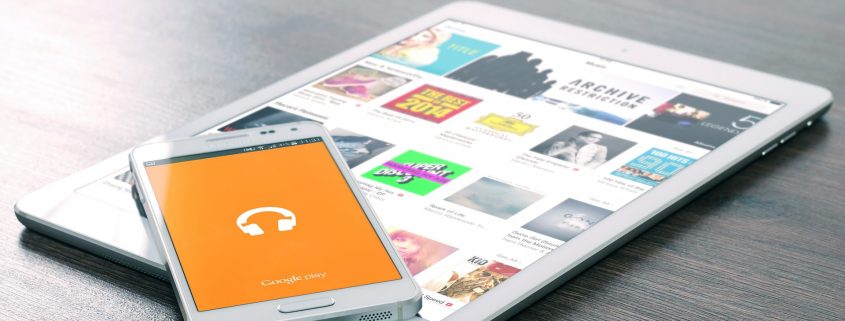How to Market Your App Effectively
If you’ve developed and published an app in the app stores, you’ve probably realized that you need to market your app in order to be succesful. In this blogpost, we will give an overview of how you can market your app the right way.
Where Should You Market Your Mobile App?
At first you have to make up your mind about which platform your app is published on and which service you want to use to market it?
iOS vs. Android
If you developed your app for both Android and iOS, on which platform should you start to market your app?
Keep in mind that iOS app marketing is more expensive than Android app marketing. Additionally, consider that iOS users are willing to spend more money for apps than Android users.
On the other hand, you need to be sure that only 12,5% of all smartphones operate with iOS whereas Android stands for more than 80% of the market share.
Which Services Should You Use to Market Your App?
There are quite a few service providers that can help you get off to the right start. In order for you to spend your money wisely, you should first consider where you need professional help the most.
User Acquisition Through Ad Networks
In order to push your app in the app store you can consider buying downloads of your app. There are two ways of doing that: Non-incentive and incentive.
Ad networks make sure that the product being advertised and the publishing site fit together, adding authenticity to the advertisement.
Building Your Own Brand
To make your app well known among potential users, you need to build your own brand for the app.
You can do that by creating an informative website that tells users what the app can do, why they should use it and how they can use it.
Of course, you should also include a link to the app store and your contact information.
This leads to another important step: Create your own social media channels on Facebook, Twitter, Instagram or YouTube.
The benefits of them can be found here.
How Should You Market Your Mobile App?
Before planning your app marketing campaign, you need to set up your budget. To calculate your budget, you have to know different operating numbers.
Two very important key figures are the Cost per Active User (CPAU) and the Customer Lifetime Value (CLTV). With these numbers you know what it costs to acquire a user and the user’s worth for your app.
Paid App Marketing
When first starting your app you can’t be sure about your apps key metrics:
- What is your average retention rate?
- How much will an active user really cost you?
- And how much money will he generate on average in his lifespan?
There are two ways of paid app marketing: the incentive app marketing and the non-incentive app marketing. Even though these two ways of market your app are
very different, both can be used at the same time.
We are recognized as a top Paid Media & Pay Per Click Company on DesignRush.
Incentive App Marketing
If you make use of the incentive app marketing, you will reward users for downloading and opening your app. Typical rewards could be giveaways, discount codes or upgrades on the game.
Incentive app marketing is an affordable way for new app providers to advertise, even if you have a small budget. You can even set a budget for a specific period of time and when the funds have been used up, the campaign stops and you will be notified.
Incentive app marketing is a tool to reach a great amount of potential users. Nevertheless, it is crucial to know that many users might only install the app to receive the award and delete it shortly after.
Therefore, the retention rate will be much lower compared to non-incentivized app marketing campaigns. This is a crucial piece of important information for calculating your budget.
Non-Incentive App Marketing
When a user decides to download an app out of interest, it is called non-incentive app marketing. Typical tools of non-incentive app marketing are banner advertisement, app reviews, social media marketing, influencer marketing or even offline marketing.
Non-incentive app marketing reaches an exact group of users that are already interested in your kind of app.
Compared to incentive app marketing, the amount of users being reached is relatively small, but the users are more likely to continue using your app, hence the retention rate will be higher compared to incentive app marketing.
In order to reach high-quality users and a huge group of users, a mixture of both incentive and non-incentive app marketing is the key.
More on this topic can be found in this article.
Social Media App Marketing
If you want to acquire a broad and high quality audience, you can contact an influencer on the social media. The influencer takes the role of a testimonial, who actively promotes your app on his/her various social media channels.
The benefit of this kind of marketing is that the influencer’s followers have a high amount of trust in their idol. They trust the influencer when he/she recommends an app and are therefore more likely to download the app as soon as possible. Possible influencers are YouTubers, Bloggers or Instagram-Stars.
Of course, you should also create your own social media channels, for example on Facebook or Twitter, and make sure that you spread the word about you app. Like this, you do not have to invest much time to start social media app marketing.
What Are the Best Ways to Market an App?
There are plenty of ways to market your app. What kind of app marketing you choose depends on your app, your company and the market you operate in.
It is always a good idea not to focus too much on only one way of app marketing, but instead to combine different tools to reach as many potential users as possible.
Furthermore, it is important to develop an app marketing strategy that is authentic.
Of course, your budget always plays a big role as well. Hence, you should always compare the CPAU for every channel to check if the chosen channel is worthwhile and necessary for your campaign. Likewise, it is important that the costs are lower than your CLTV.
If you want your app to be successful in the crowded market, you will need a great app marketing strategy. AyeT-Studios can you help you to plan such a campaign customized for your specific app and your needs.
















